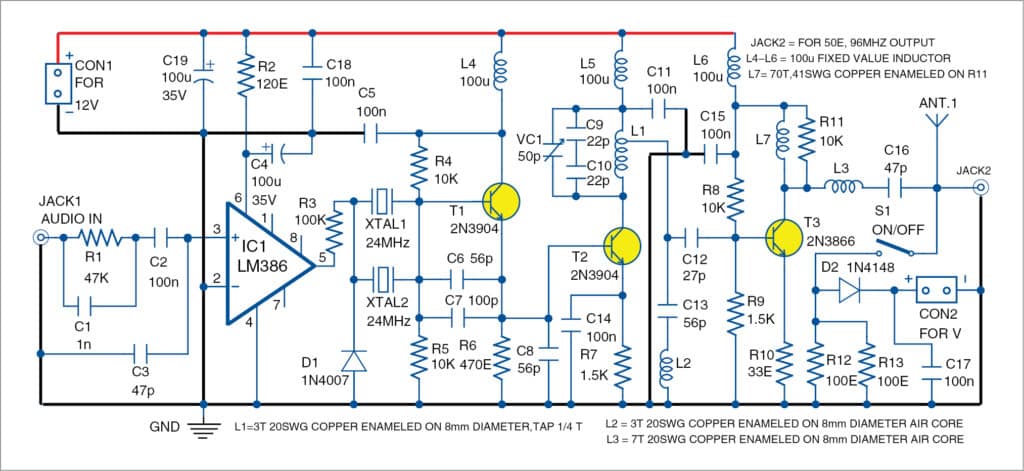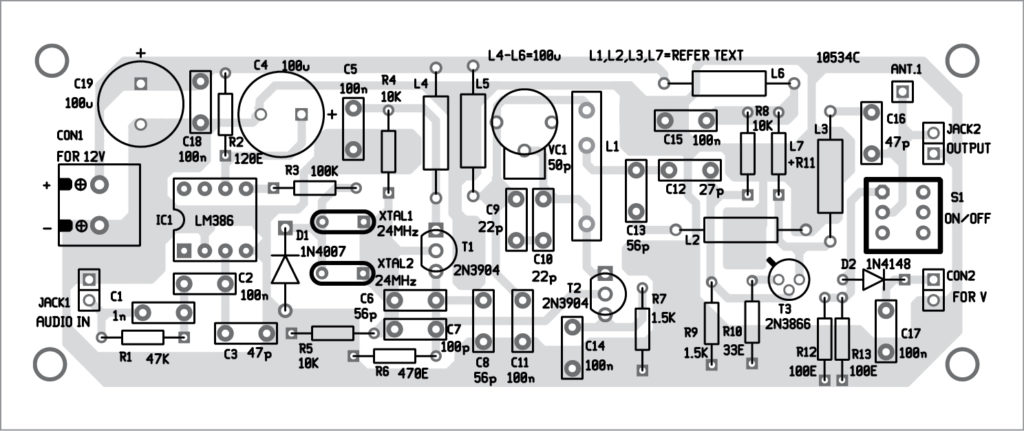 The circuit presented here uses a crystal oscillator and frequency multiplier to generate a highly-stable carrier signal frequency of 96MHz. With 40mW of RF output, it can be used to transmit voice or music up to hundred metres.
The circuit presented here uses a crystal oscillator and frequency multiplier to generate a highly-stable carrier signal frequency of 96MHz. With 40mW of RF output, it can be used to transmit voice or music up to hundred metres.
The circuit diagram of the 96MHz crystal-locked FM transmitter is shown in Fig. 1. The circuit is built around a low-power audio amplifier using LM386 (IC1), transistors 2N3904 (T1 and T2) and 2N3866 (T3), 24MHz crystals (XTAL1 and XTAL2), rectifier diode IN4007 (D1), signal diode IN4148 (D2) and a few other components.

A low-power 24MHz Colpitts oscillator is built around T1 along with biasing resistors R4, R5 and R6, and capacitors C6, C7 and C8.
Transistor T2 is a buffer amplifier and its collector is rich in harmonics. The tank circuit comprising inductor L1, capacitors C9 and C10, and trimmer capacitor VC1 is tuned to four times the oscillator frequency, that is, 96MHz. T2 boosts the fourth harmonic of 96MHz and suppresses the 24MHz fundamental, second (48MHz) and third (72MHz) harmonics by at least -24dBc, or 250 times.
Inductor L2 and capacitor C13 make a series-tuned (72MHz) harmonics trap and attenuate the strong third harmonic to ground. Readymade 100µH moulded inductors (L4 through L6) isolate the power supply from transistors T1 through T3 to help minimise interference between different stages.
T2 feeds power amplifier T3 with approximately 5mW of RF drive via 1/4-turn tap from the top of tuning coil L1. T3 is biased for class A operation. Standing current is set to 20mA with resistors R8, R9 and R10.
40mW of RF power is available at collector of T3. Matching network comprising L3 and C16 transforms output impedance of T3 to 50-ohm impedance of the antenna. (A 78cm long single-strand wire was used as an antenna during testing.)
Audio amplifier IC1’s frequency modulates oscillator T1 by varying capacitance of diode D1, which is connected in series with XTAL1 and XTAL2. (Note that XTAL1 and XTAL2 are connected in parallel to have greater frequency deviation.) The transmitter accepts audio input from an external source such as cellphone. External volume level should be set for best audio level output. R1 and C1 add 50µs pre-emphasis to boost higher audio frequencies. Increasing R1 to 15-kilo-ohm changes pre-emphasis to 75µs.
Construction and testing
A PCB layout of the FM transmitter is shown in Fig. 2 and its components layout in Fig. 3. After assembling the circuit on the PCB, connect 12V DC across CON1.
Keep all leads short. The prototype was built on a piece of copper-clad board using ugly bug construction method. The large ground plane of the copper board gives excellent results for the VHF circuit. With S1 on and 50-ohm dummy load (R12 and R13) connected, apply 12V regulated power supply.


Download PCB and Component layout PDFs: click here
Carefully tune VC1 for maximum voltage (V) reading at CON2. Output power in milliwatts equals
(V+0.5V diode loss) squared/100
No further adjustment is required.
A cheap USB SDR dongle and free spectrum analyser software may be used to observe output. It can be downloaded from https://www.rtl-sdr.com/tag/spectrum-analyzer-2/
Fine tuning of VC1 can also be done using a handheld FM receiver. Make sure a wire antenna is connected in the transmitter circuit.
Now, with FM receiver in your hand, slowly walk away from the transmitter. Correct tuning of VC1 will give maximum range on 96MHz. T3 can be replaced with 2N3904. In this case, increase R10 to 56-ohm. Power output will drop to 15mW.
Use a suitable heat-sink for 2N3866. Care should be taken to keep L1 and L2 2cm apart and at ninety degrees to each other on the PCB.
Spectrum output of the transmitter obtained is in the range of 24MHz to 700MHz. Second and third harmonics of 96MHz are down to -18dBc and -24dBc, respectively. All other spurs or distortions are below -20dBc.
Switch S1 should be off when antenna is connected. Use a shielded cable for input audio connection.
Some inductors are self-made, while others are readymade. L1 is a three-turn 20SWG copper-enameled coil on 8mm diameter air core, tapped 1/4 turns from positive side. L2 also is a three-turn 20SWG copper-enameled wire on 8mm diameter air core. L3 is seven-turn 20SWG copper-enameled wire on 8mm diameter air core. L4 through L6 are 100µH fixed-value coils.
Inductor L7 is made of 70 turns of 41SWG copper enameled wire on resistor R11.
Joy Mukherji is an electronics hobbyist who likes designing radio frequency circuits







Can I PCB and components availble
Kindly elaborate your query.
How make a photo sensor machine
Kindly elaborate your query.
HI there
Please advise?
How can I increase output on this transmitter?
Use an amplifier. I tested BS170 mosfet and it delivers 0.5W on the FM band with 15mW in. Want the schematic?
I’ll publish the circuit soon in EFY.
Hello sir
can you explane me why you use two 24MHZ xtal ?
This is the reply from author Joy Mukherji:
The circuit is basically a variable crystal oscillator (VXO). Two parallel crystals are better than one in a VXO as the frequency can be pulled a little bit more. This results in more deviation and louder audio in my FM transmitter.
The specification of this transmitter is dreadful. The spurious products are only -20dBc. Proper transmitters have spurs in the range of -70cBc to -90dBc. Trying to deviate a crystal (or pair of crystals) will give very distorted modulation. This circuit is a waste of components!
24-294 MHz spectrum analyzer shot. T3 is 2n3866A.
https://ibb.co/z4f36VM
A simple low pass filter should remove all the spurs above 96MHz. As you can see, the spurs below our transmit frequency are close to the noise floor. This is in fact a very good transmitter for hobby use as it lacks complicated filters and PLL circuitry but offers crystal stability!
Sound quality here. Playing Arijit Singh. A 2n3904 used as final. C16 increased to 100p and R10 increased to 47ohm plus 56p cap added in parallel.
Schematic with 2n3904 final https://imgbb.com/M12KzWC
Sound quality playing music https://youtu.be/tyByYquCOlo
Then present a better circuit of your own with multiple coils and a 7 pole BPF to suppress the spurs by -50dBc or more and an amplifier chain with several transistors to boost the output from band pass filter to +12dBm or more. This circuit was aimed at your average hobbyist and to keep things simple there is only a single variable capacitor for tuning. It will work the first time if built properly and has a decent range. The distortion is low enough for voice. It illustrates the simple technique of modulating a crystal for NBFM. This technique has been used in VHF amateur radio transceivers as well for the 2m ham band. My main design goals were rock solid frequency stability, an usable output power with common 2n3904 transistors, and simplicity. This circuit is also there on Harry Homebrew sm0vpo web pages along with the spectrum analyzer screenshots. Google it.
Correction: The 2n3866, if used, does not need a heatsink in this circuit as Ic or collector current is just 20ma or so. Even if a 2n3904 is used as PA and its plastic body warm, it still does not require any form of heatsink as power levels are quite low.